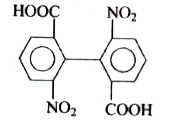Draw the structural isomer of C3H6Cl2 which can exhibit optical isomerism.
To solve the problem of drawing the structural isomer of C₃H₆Cl₂ that can exhibit optical isomerism, we need to follow these steps:
Step 1: Understand the molecular formula
The molecular formula C₃H₆Cl₂ indicates that we have three carbon atoms, six hydrogen atoms, and two chlorine atoms.
Hint: Count the number of atoms in the molecular formula to understand the structure you need to create.
Step 2: Identify the requirement for optical isomerism
For a molecule to exhibit optical isomerism, it must have a chiral center. A chiral center is typically a carbon atom that is bonded to four different groups.
Hint: Look for a carbon atom that can be attached to four different substituents.
Step 3: Construct the carbon skeleton
Start with a three-carbon chain (propane). We can arrange the carbon atoms in a way that allows for different groups to be attached.
Hint: Draw a straight chain of three carbon atoms (C-C-C) as your base structure.
Step 4: Attach the substituents
1. Attach a methyl group (CH₃) to one of the terminal carbons.
2. Attach a hydrogen atom (H) to the same carbon.
3. Attach a CH₂Cl group to the middle carbon.
4. Attach a Cl atom to the other terminal carbon.
This gives us the following structure:
CH3|H−C−CH2Cl|Cl
Step 5: Confirm chirality
In the structure above, the middle carbon (C) is bonded to four different groups:
- CH₃ (methyl group)
- H (hydrogen)
- CH₂Cl (chloromethyl group)
- Cl (chlorine)
Since all four groups are different, this carbon is a chiral center, and thus the compound can exhibit optical isomerism.
Hint: Verify that the central carbon is attached to four distinct groups to confirm chirality.
Final Structure
The final structural isomer of C₃H₆Cl₂ that can exhibit optical isomerism is:
CH3|H−C−CH2Cl|Cl
Summary
We have drawn the structural isomer of C₃H₆Cl₂ that can exhibit optical isomerism by ensuring that one of the carbon atoms is a chiral center with four different substituents.
The molecular formula C₃H₆Cl₂ indicates that we have three carbon atoms, six hydrogen atoms, and two chlorine atoms.
For a molecule to exhibit optical isomerism, it must have a chiral center. A chiral center is typically a carbon atom that is bonded to four different groups.
Start with a three-carbon chain (propane). We can arrange the carbon atoms in a way that allows for different groups to be attached.
1. Attach a methyl group (CH₃) to one of the terminal carbons.
2. Attach a hydrogen atom (H) to the same carbon.
3. Attach a CH₂Cl group to the middle carbon.
4. Attach a Cl atom to the other terminal carbon.
In the structure above, the middle carbon (C) is bonded to four different groups:
- CH₃ (methyl group)
- H (hydrogen)
- CH₂Cl (chloromethyl group)
- Cl (chlorine)
The final structural isomer of C₃H₆Cl₂ that can exhibit optical isomerism is:
We have drawn the structural isomer of C₃H₆Cl₂ that can exhibit optical isomerism by ensuring that one of the carbon atoms is a chiral center with four different substituents.
Topper's Solved these Questions
- HALOALKANES AND HALOARENES BOOK - ICSECHAPTER - HALOALKANES AND HALOARENES EXERCISE - EXERCISE (PART - II DESCRIPTIVE QUESTIONS) (SHORT ANSWER QUESTIONS)
94 Videos
- HALOALKANES AND HALOARENES BOOK - ICSECHAPTER - HALOALKANES AND HALOARENES EXERCISE - EXERCISE (PART - II DESCRIPTIVE QUESTIONS) (LONG ANSWER QUESTIONS)
65 Videos
- HALOALKANES AND HALOARENES BOOK - ICSECHAPTER - HALOALKANES AND HALOARENES EXERCISE - EXERCISE (PART - I OBJECTIVE QUESTIONS)
1 Videos
- GENERAL PRINCIPLES AND PROCESSES OF ISOLATION OF ELEMENTS BOOK - ICSECHAPTER - GENERAL PRINCIPLES AND PROCESSES OF ISOLATION OF ELEMENTS EXERCISE - EXERCISE (PART-I ( OBJECTIVE QUESTIONS )) (Fill in the blanks)
60 Videos
- ISC QUESTION PAPERBOOK - ICSECHAPTER - ISC QUESTION PAPEREXERCISE - PART-II(SECTION-B)
74 Videos
Similar Questions
Knowledge Check
The compound which does not exhibit optical isomerism is
ACH3CHBrCOOHBCH2ClCH2COOHCCH3CHOHCOOC2H5DCH3CHOHCOOHWhich of the following compounds exhibit optical isomerism?
A BH2C=C=CH2C
BH2C=C=CH2C D
D
Draw the structural isomer of [Co(NH3)5NO2]Cl2 and name the type of isomerism.
View SolutionDraw the structural isomer of [Co(NH3)5NO2)Cl2 and name the type of isomerism.
View SolutionDraw isomers of C4H10
View SolutionThe number of structural isomers for C6H14 is
View SolutionWhich of the isomers of n-butyl alcohol exhibit optical isomerism ?
View SolutionWhich of the following can exhibit geometrical isomerism?
View Solution
